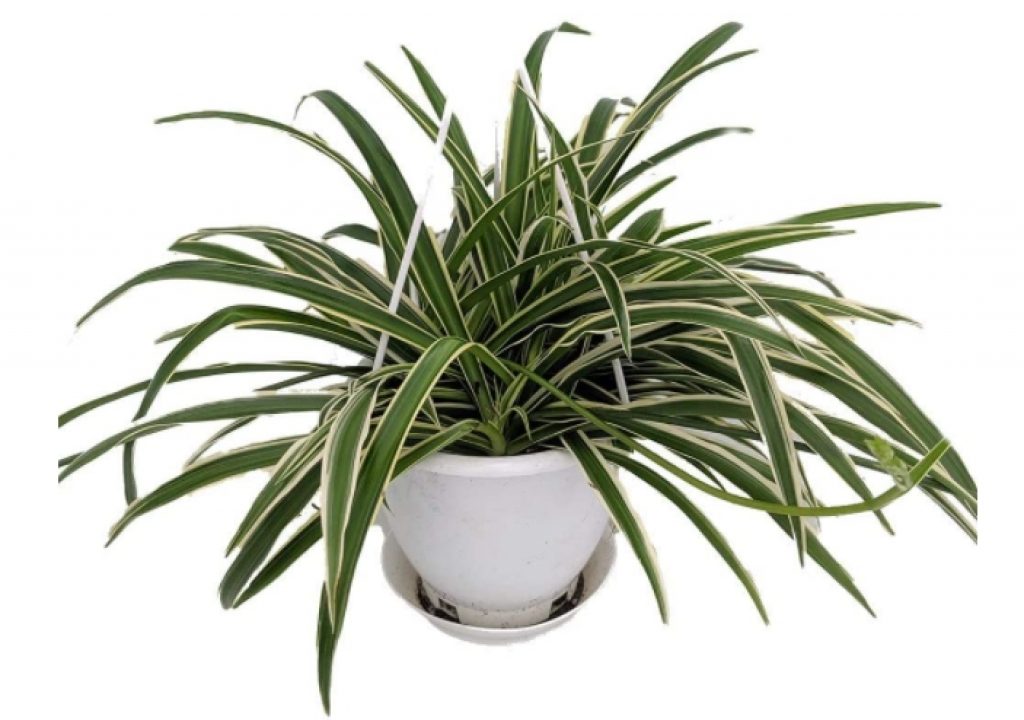Chlorophytum comosum, popularly known as spider plant but has other names like St. Bernard’s lily, hen and chickens, airplane plants, spider ivy, and ribbon plant, is a perennial flowering in the Asparagaceae, native to southern and tropical Africa.
The genus Chlorophytum is also known as spider plant and it has about 200 different species.
Are they safe or poisonous?
Chlorophytum Comosum, airplane plants, or spider plants are safe for cats and other pets, i.e., they are not toxic or poisonous to not just your cats but also dogs and horses.

We all know that cats are obligate carnivores. However, since they tend to eat a little bit of greeneries, including grass, garden, and houseplants, it is a good idea to have only safe houseplants or ensure your cats cannot access them if they are toxic.
Besides being safe, these popular houseplants with all green leaves (less popular) and variegated leaves cultivars, Vittatum and Variegatum, both with the Royal Horticultural Society’s Award of Garden Merit are very easy to grow.
Finally, it would be best to consider these ornamentals because they will reduce indoor air pollution as they remove formaldehyde and xylene from your household. These volatile Organic Compound (VOC) pollutants come from paints, lacquers, adhesives, permanent magic markers, gasoline, rust preventers, and so on.
Growing them
Since spider plants are cat-friendly houseplants, i.e., they not dangerous to your cat or even other pets, you may be interested to know how to grow or care for them.
Some of their care requirements include the following:
- Light: While they flourish best in bright indirect light, they can still tolerate low indirect light. However, avoid direct sunlight if you don’t want sunburnt leaves.
- Watering: They need moist soil but don’t overwater them since it will result in root rot. Water them more often during summer and reduce when winter comes. You can also mist them from time to time during summers.
- Temperature: Ideal temperatures are 60–80 degrees Fahrenheit. However, they can tolerate lower temperatures so long as it doesn’t go below 50 degrees Fahrenheit.
- Humidity: They can tolerate lower humidity. However, they will thrive best in higher humidity.
- Fertilizing: Feed them with fertilizers once or twice a month during spring or summer when they are growing. Don’t feed them during winter or autumn.
- Soil: They need a well-drained potting soil-based mixture.
Common issues
While growing them, common issues include tip burn if kept under low humidity, the soil is dry, or has chemicals or salt buildup. Avoid water with chlorine or fluorine.
Finally, they may have scale, and mealybugs are the two common pests that may eat your spider plants.
Other safe plants
If you don’t want to protect your plants from your cats, only have pet-safe houseplants or even garden ornamentals. Some of the good ones to buy include:
- Bromeliad
- Christmas cactus
- Echeveria glauca
- Friendship plants
- Ghost plants
- Haworthia zebra
- Maidenhair fern
- Moth orchid
- True palms like areca, parlor, pigmy, kentia, etc.
- Calatheas like medallion, rattlesnake, peacock plant, among others
Conclusion
To conclude, on cats and spider plants, it is good to mention that while they are ok, it doesn’t mean that your cat can munch down a whole plant as they can still suffer from digestive upsets.
If you see your cat overeating greeneries, it may be due to boredom, nutritional deficiency, or pica, and you may want to enlist the help of your vet.
